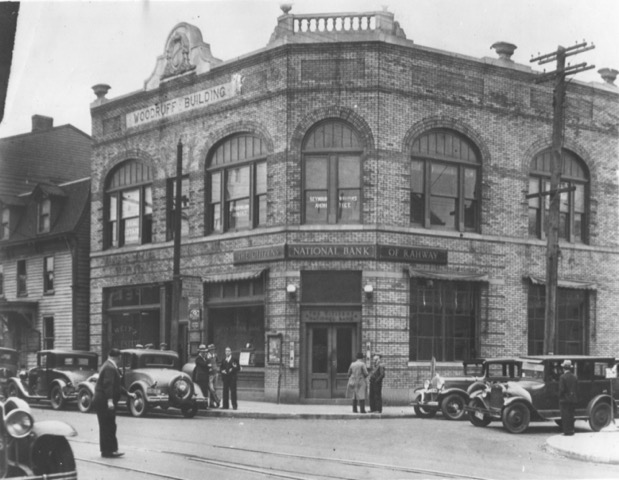
Citizens National Bank Heist
Submitted by Al Shipley, City Historian and Rahway Library Research Consultant
Throughout the 1930s, notorious bandits such as John Dillinger, “Machine Gun” Kelly, and “Pretty Boy” Floyd were at the height of their infamy. News agencies would follow their criminal exploits and broadcast detailed stories containing the lurid accounts of their devilry. Although those particular fore-mentioned criminals operated in mid America, bank jobs were not restricted to the rural regions of the country. High stakes robberies were also being committed in towns and cities east of the Mississippi. Even in places like Rahway, New Jersey.
One such crime actually did take place in 1931 when four armed robbers entered the Citizens National Bank and absconded with over $70,000 (nearly 1.25 million in 2021 dollars). The four crooks, plus their getaway driver, may never have reached the notoriety of a Bonnie and Clyde or a “Baby Face” Nelson, but they did out-do them in one very important respect – they never got caught.
At exactly 8:10 a.m. on Friday, November 13, an armored car arrived in front of the Citizens National Bank at the corner of Irving and Lewis Streets. J. H. Farrell, manager of the Gibbs and Hill Construction Company, got out of the vehicle carrying two heavy sacks. He was accompanied by two Rahway policemen. The Gibbs and Hill contractors had been working on electrifying the Pennsylvania Railroad for several months and each Friday Farrell came to the bank to deposit the payroll. Once he was safely inside, the police escorts were relieved of their duty.
According to eye witnesses, at 8:20, just ten minutes after the payroll was carried in, four neatly dressed men strolled into the building. Six bank employees and five patrons were in the lobby engaged in customary banking business. Without any apparent verbal signal, the four intruders drew their weapons and one of the robbers calmly announced, “If you utter a word or try to get away, you’ll get your head blown off.” A second robber lined everyone against a wall while another kept an eye on the cashiers. The fourth, flourishing his revolver, went behind the teller cages to the area where the head teller, two women clerks, and Farrell were counting out the Gibbs and Hill payroll. Holding his gun on the surprised counters, the robber hastily scooped the piles of cash into waste baskets. As the money was being gathered, the employees and customers who were held in the lobby were quickly herded into a back room near the vault. Strangely, the robbers showed no interest in gaining access to the vault nor did they search individuals for cash or valuables. When the entire payroll was cleared off the counting table, the gunman told Farrell and the three bank employees to lie on the floor and to keep down for five minutes. He shouted to his accomplices, and the men hurried out the front door. Once outside, they jumped into a large, black sedan driven by a fifth man, sped south down Irving Street, skidded left onto Milton Avenue, and raced toward State Highway 25 (now U.S. 1&9). The entire heist took less than five minutes.
The bank had no alarm system. By the time one of the cashiers telephoned police headquarters, the robbers were away from the scene and long gone. After the police arrived at the bank and assessed the situation, they flashed an alarm across the state over their new teletype system. The ensuing search for the perpetrators would weave an unusual story of escape – one filled with miscalculation and luck.
The next day, an abandoned black sedan was found far off a back road outside of town near Lambert’s Dock on the Rahway River. The vehicle was discovered by two men who were hunting rabbits in the wooded fields of the Bayway oil refinery property. The men also found a bag containing three loaded pistols, packages of cartridges, and a man’s overcoat. A 32-foot speedboat, its propeller buried in the soft mud, was found on the Linden side of the river. It was later learned that the boat had been reported stolen. The police also received a tip that two suspicious looking men, who appeared to be carrying money bags, had been seen getting out of a car in Newark. It was noted that after they alighted, a young man slid onto the driver’s seat and drove off. A teen was later arrested at his home in Elizabeth when it was established that his license plate matched the car seen in Newark. The 17-year-old spent a night in jail, but was released when the account of his innocent involvement in the case was corroborated.
In the days and weeks that followed, the police pierced together the scenario of how the robbers had made their escape. They believed that the robbers must have spent several weeks casing the bank and that the Gibbs and Hall payroll was their sole target. The robbers knew the exact time the payroll was always delivered, the routine of the police escort, and even the layout of the bank. Their plan was to get away in the motorboat while police roadblocks were positioned on the highway. However, when the robbers discovered the motor boat had sunk during the low tide and could not be started, they set out on foot in the direction of the highway. Unfamiliar with the terrain, they soon found themselves sloshing through the muddy water of the marshland. But then luck struck for the assailants. They spied a vehicle parked on a dirt road next to the fields where a young driver was waiting for his father and uncle to return from hunting rabbits. The men, wet to the waist, got in the car, and with one of the men taking the wheel, drove to Newark. It is likely some of the gang left the car and split up during the trip. Upon reaching the big city, the remaining robbers gave the youth $100.00 of the stolen money and told him to take his time going back.
Numerous clues would turn up, Rogues Gallery photos were examined by those who were present in the bank, and some men were taken into custody; in the end however, no one was charged. The culprits of the greatest robbery in the annals of Rahway history were never brought to justice.





